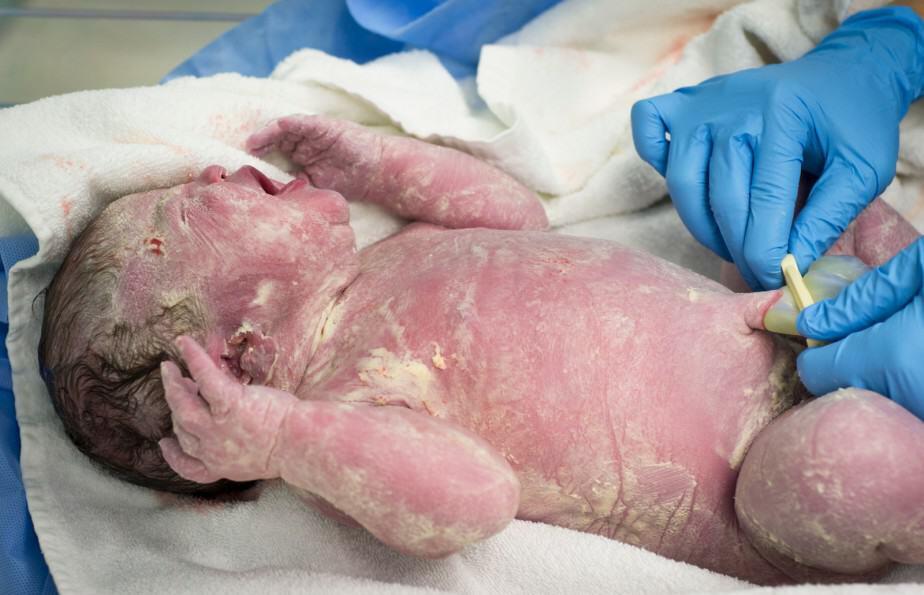Delayed cord clamping means desire to clamp umbilical cord a little later than we used to do over the last 30-40 years. However, it is nothing new if we go back in history to ancient times.
Aristotle, in the 4th century BC, said that cutting the umbilical cord too soon was dangerous. Later on, Erasmus, in the 18th century AC, said: “Another thing very injurious to the child is the tying and cutting of the navel string too soon, which should always be left till the child has not only repeatedly breathed but till all pulsation in the cord ceases.”
What is delayed cord clamping?
Between the 1960s-2000s, we used to clamp the umbilical cord after the baby took several breaths, which was about 15-20 seconds after birth. Nowadays, if a baby is stable, doctors are willing to wait for at least 30 seconds and as long as 5 minutes before tying and cutting the umbilical cord.
Most experts agree that an umbilical cord clamping that is done beyond 30 – 60 seconds after the birth should be considered as the delayed umbilical cord clamping.
The umbilical cord is a string-like connection between a mother and a fetus. It contains one vein and two arteries. Blood circulating in the umbilical vein picks up oxygen and essential nutrients from the placenta and releases them inside the fetus’s tissues. Blood flowing in the umbilical arteries is deoxygenated and has fewer nutrients and more waste products. Placenta serves the purpose of providing everything that’s needed for the fetus to live and grow. The placenta is a somewhat spongy organ, and after the baby’s birth, it can still push some additional blood into the baby’s body if enough time is allowed for it.
According to various estimates, if umbilical cord clamping is delayed for 3-5 minutes, the baby may receive an additional 60-100 ml of blood. That extra blood will help the baby avoid anemia, low iron stores, and possibly will have a positive impact on its health and developmental outcomes.
How long should you wait to clamp the cord?
Depending on who you are going to ask, the answer will differ. Let’s review what different professional organizations say about the length of time we should wait until clamping the umbilical cord in a baby after birth.
World Health Organization (WHO) recommends that we do cord clamping not earlier than 1 minute after birth and possibly as late as 3 minutes after birth. They modify their statement for babies who do not cry or breath and do not respond to drying and stimulation efforts. Those babies will need positive pressure ventilation (the first step in cardiopulmonary resuscitation for a baby). Therefore, the umbilical cord needs to be clamped sooner to allow for resuscitation efforts.
American College of Obstetricians and Gynecologists (ACOG) suggests that for premature and full-term babies who are vigorous, providers perform umbilical cord clamping at least 30-60 seconds after birth.
American College of Nurse-Midwives states that: “For term newborns, delaying the clamping of the cord for 5 minutes if the newborn is placed skin-to-skin or 2 minutes with the newborn at or below the level of the introitus ensures the greatest benefit.”
At this time, we do not know the exact amount of time that could be beneficial for the baby before we clamp the umbilical cord. However, it is clear that everybody agrees; it should not be just 15-20 seconds what has been practiced until recently.
Benefits of delayed cord clamping
Premature babies seem to benefit the most from the delayed umbilical cord clamping. Various studies in premature babies reported on higher red blood cell volume-thus more stable blood pressures after birth, decreased need for blood transfusions, and lower incidence of necrotizing enterocolitis and intraventricular hemorrhage.
In full-term babies, delayed cord clamping contributes to increased hemoglobin levels after birth and an improved amount of stored iron in the first months of life. That, in turn, may potentially lead to better developmental outcomes; however, in my opinion, the latter benefit has not been proven well enough yet.
Can delayed cord clamping be dangerous?
Adverse effects on the baby from delayed cord clamping include slightly increased rates of jaundice requiring phototherapy and higher rates of clinically insignificant polycythemia. Delayed cord clamping does not affect mortality rates in babies. Obviously, one should remember that resuscitation efforts in babies that need them, should never be delayed due to desire to perform delayed cord clamping.
Early cord clamping has been done in the past to avoid maternal bleeding. People believed that they needed to clamp the cord soon after delivery to manage the third stage of delivery and minimize the possibility of severe maternal bleeding.
Data from the studies proved us wrong. A review of 5 trials that included 2200 women with delayed cord clamping showed that they did not have more frequent postpartum bleedings, nor required more blood transfusions when compared to women with early cord clamping. Also, both groups had similar levels of hemoglobin after the delivery of the baby.
In cases where women are at much higher risk of postpartum hemorrhages such as placenta previa or placental abruption, delaying cord clamping may not be a wise decision. A mother’s health may need to take precedence over the benefits of delayed cord clamping for the baby.
Can delay in cord clamping cause jaundice?
Opinions on that subject are mixed. It seems logical that if delayed cord clamping increases the number of red blood cells in a newborn, it should also lead to higher levels of bilirubin and jaundice in babies. On a side note, bilirubin is a chemical produced from hemoglobin, which is part of red blood cells; thus, there is a direct relationship between the amount of hemoglobin in a newborn and the amount of produced bilirubin. Bilirubin gives a yellow color in the skin and is a measurable indicator of the severity of jaundice.
If any effects on rates of jaundice exist, they are probably not very strong. Cochrane’s review found increased risks of jaundice disease requiring treatment with phototherapy if umbilical cord clamping was delayed. However, the meta-analysis conducted by Hutton and another one by Mathes contradicted those results and did not find any difference.
What babies may be at risk from delayed cord clamping?
One of the possible side effects of delayed cord clamping is polycythemia in a newborn baby. Polycythemia is defined as an abnormally increased amount of red blood cells in the circulation. It is frequently assessed by measuring so-called Hemoglobin or Hematocrit. In polycythemia, the blood becomes more viscous (=sticky, slow-flowing), and that may lead to infarcts, low oxygen levels in the brain, and many other possible complications. Frequently, polycythemia is accompanied by low glucose levels and low platelet levels.
In larger populations, studies comparing groups of babies with early versus delayed cord clamping did not show differences in rates of clinically significant polycythemia. However, I am not aware of good-quality studies looking specifically into the effects of delayed cord clamping among populations that already have an increased incidence of polycythemia.
Babies who have increased risk of developing polycythemia and perhaps should not be offered delayed cord clamping are:
- Born at high altitude
- Babies with IUGR (Intrauterine Growth Restriction)
- Babies of mothers with diabetes
- Infants large and small for gestational age
Can you request a delayed cord clamping?
Cord clamping has to be done in a timely fashion after the birth of each baby. If you have a strong preference, you should talk to your provider about any potential benefits and risks associated with it and make it clear in the labor room what is that you desire. It may also help if you put it into your birth plan.
Your choices regarding cord clamping will be:
- Leave it up to a doctor or midwife to decide
- Early clamping after few breaths – 15-20 seconds (especially if you want to bank cord blood)
- Delayed cord clamping 30-60 seconds
- Delayed cord clamping for 1-5 minutes
- Cord clamping after umbilical cord stops pulsating
- Lotus delivery (do not detach placenta from the baby after birth)
- Having baby skin to skin while waiting for cord clamping
As you can see, you have many choices. I do not have an answer to what could be the best option for you. Only you and your doctor or midwife can decide. Each situation will be different, and sometimes depending on your condition or condition of your baby plan will need to change.
Delayed cord clamping and cord blood banking
Since one of the major benefits of delayed cord clamping is an increase in the amount of blood transferred to the baby from its placenta after birth, there will be less blood left in the placenta available for the banking. Cord blood banking involves the extraction of fetal blood rich in stem cells from the placenta and umbilical cord.
One report cited that 39% of units obtained from babies with early cord clamping passed initial screening criteria for blood banking as opposed to only 17% of units taken from babies who had cord clamping delayed for at least 60 seconds.
The cord blood can be donated for research or given to publicly available storage facilities, or families may preserve it in private storage facilities for a yearly fee. Cord blood can be used for bone marrow transplants in the treatment of hematologic cancers. It may have even more potential uses in the future as our science advances with time, and we learn how to utilize those stem cells to its fullest potential.
If you want to know what are other procedures that your baby will need after birth in the hospital, read my article on this topic here.
Disclaimer:
This article is only for general information purposes. It should not be viewed as any medical advice. There is a chance that information here may be inaccurate. It would be best if you always discussed all health-related matters with your doctor before making any decisions that may affect your health or health of your family members.

